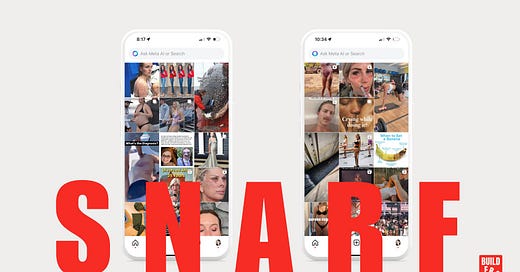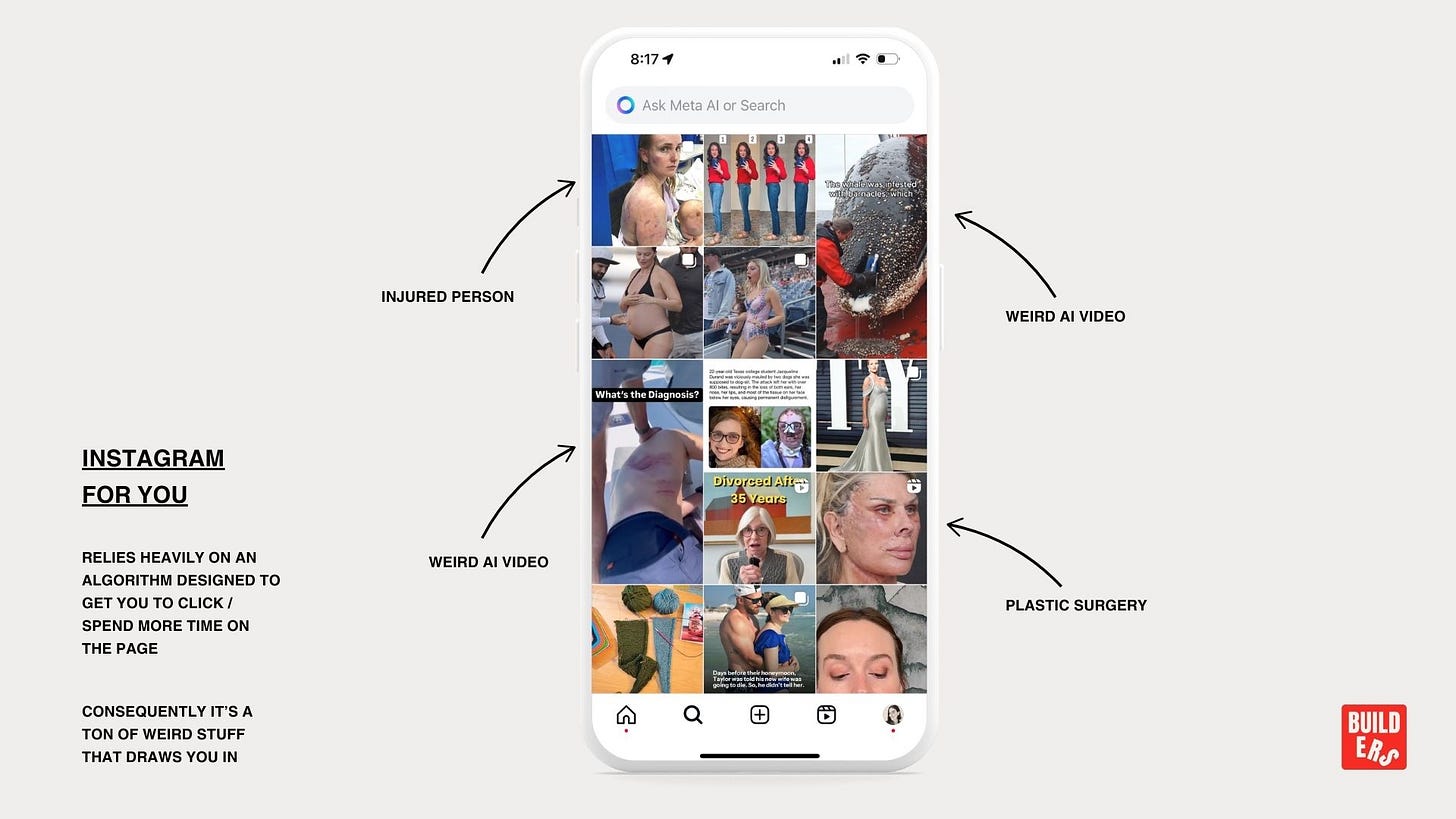Get in loser, we're going SNARFing!
Stakes, Novelty, Anger, Retention, and Fear - the hidden framework reshaping the products you use everyday
👋🏻 Hi, it’s me Nickey Skarstad and welcome to Builders, where I break down what it actually takes to build products that people love (and actually use). No fluff, just hard-earned lessons.
A few weeks ago, the CEO of Buzzfeed wrote a manifesto about the devolving arms race we’re seeing on social media platforms as more and more creators and platforms compete for watch-time. While his acronym isn’t perfect SNARF (Stakes, Novelty, Anger, Retention, and Fear!), it surfaced something that’s hard to miss - employing these tactics will help you get more watch-time and drive growth on your platform. But what does this mean for consumer tech and how we build prodcuts? Read on as we explore👇🏻
A few months back, I wrote about the Dopamine Industrial Complex™️ and how game mechanics are reshaping consumer products. Today, I want to dive deeper into a related phenomenon that's fundamentally changing how we build and market digital products: SNARF.
What is SNARF?
SNARF stands for Stakes, Novelty, Anger, Retention, and Fear. And it's not just a set of tactics, it's the evolved outcome of AI-powered platforms optimizing for engagement at all costs. The acronym was coined by Jonah Peretti, founder of Buzzfeed, who noticed that the “best” content published on Buzzfeed wasn’t getting the most clicks.
“… the content that is working isn’t our best content.” -Jonah Peretti
Let's break it down:
Stakes: Artificially elevating the importance of content ("You NEED to know this!")
Novelty: Manufacturing uniqueness to trigger curiosity ("I've never seen anything like this!")
Anger: Provoking outrage to drive engagement ("This will make your blood boil!")
Retention: Using cliffhangers and withholding information ("Wait till the end!")
Fear: Creating anxiety about missing out or social status ("Everyone knows this but you!")
While this framework originated in content marketing, it's rapidly becoming the blueprint for consumer product design across industries. It’s leaning into anything that might trigger you, and using it as a wedge to get you to pay attention.
Why SNARF is winning
The rise of SNARF isn't accidental. It's the predictable result of two converging forces:
AI recommendation systems optimizing for engagement
When platforms use deep learning to maximize usage without caring about content quality, SNARF naturally emerges as the winning formula.The attention bottleneck
As the barriers to building products lower (thanks to AI, no-code tools, etc.), the real constraint becomes user attention. This creates a Darwinian environment where your content or product will only survive if it stands out.
The success is undeniable. TikTok built a global empire following this playbook. Meta pivoted its entire product strategy to follow suit. The results speak for themselves: engagement goes up and retention improves.
Real-world examples
Let's look at how SNARF manifests in products we interact with daily:
Instagram's For You page has become a minefield of emotionally charged content designed to keep you scrolling. Notice how the algorithm increasingly serves you posts designed to provoke strong reactions … whether outrage at a political statement, anxiety about a health claim, or FOMO about a trend you've missed.
TikTok's For You tab is perhaps the most refined SNARF delivery system. As a TikTok creator myself, I've noticed my posts that generate arguments in the comments consistently outperform my more neutral content. The algorithm rewards content that triggers emotional responses, particularly anger and debate.
And it's not just content platforms. SNARF is infiltrating every category of consumer tech:
Fintech apps: Creating artificial urgency around basic money decisions
Productivity tools: Using shame and social comparison to drive daily usage
Health & wellness: Exaggerating consequences of missed activities
Dating apps: Manufacturing scarcity to drive premium subscriptions
E-commerce: Creating countdown timers and "limited stock" warnings
Even LinkedIn has embraced game mechanics—a gateway into broader SNARF tactics.
The builder's dilemma
This creates a genuine ethical crossroads for those of us building products:
As user acquisition costs continue to go up and competition for attention intensifies, can we afford not to use these proven engagement tactics? Yet if we embrace them, are we contributing to digital environments that manipulate rather than empower?
The growing backlash
Despite its effectiveness, there are signs that SNARF may have a limited shelf life. Recent research from the National Bureau of Economic Research found that many users would actually pay money for platforms like TikTok and Instagram to not exist—suggesting these products have negative utility despite their popularity.
Consumers are also becoming more aware of manipulation tactics. Screen time reports, digital wellness tools, and growing public chatter around tech ethics are creating more conscious users. Some segments—particularly younger users—are developing a refined BS detector for SNARF tactics.
Building beyond SNARF
So how do we build products that capture attention without resorting to manipulation? Here’s how to do it right:
1. Transparency as a competitive advantage
Be honest about how your product works. Explain recommendations. Show your work. As users become more sophisticated, transparency becomes a differentiator.
Notion and Figma have both grown primarily through genuine utility rather than psychological manipulation. While they employ some engagement features, they're anchored in actual value creation.
2. Align incentives with user wellbeing
Structure your business model so that your success correlates with user satisfaction, not just engagement. Subscription models tied to genuine value delivery (rather than attention harvesting) create healthier alignment.
Duolingo promotes a quality metric called time spent learning well that optimizes for learning alongside growth.
3. Curate, don't just optimize
Human curation and editorial judgment are making a comeback. While AI can optimize for engagement, it often lacks the judgment to optimize for quality, relevance, and long-term satisfaction.
As big platforms move away from reviewing content, there’s an opportunity for more boutique content curation that has a perspective on what is good. (Please build this!)
4. Design for agency, not addiction
Give users meaningful control over their experience. Help them achieve their actual goals rather than manufacturing needs. Build products that respect time and attention as finite resources.
5. Ethical engagement tactics
Not all engagement tactics are manipulative. Create retention through genuine delight, meaningful achievements, and social connection—not through fear, urgency, and manipulation.
Questions worth asking
Next time you're making product decisions, consider:
If our metrics improved but users felt worse afterward, would we consider that success?
Are we solving real problems or manufacturing artificial ones?
Would we be comfortable explicitly explaining our engagement tactics to users?
Are we building a product we'd want our own families to use?
Does our product give people more agency or less?
The opportunity ahead
For all the challenges SNARF presents, it also creates opportunity. As the dominant platforms double down on AI-driven engagement at all costs, they leave space for meaningful alternatives that prioritize quality, satisfaction, and genuine utility.
Builders who pioneer new models that respect user agency may not win the short-term metrics game, but they're positioning themselves for the inevitable shift in consumer preferences.
I'd love to hear how you're navigating these waters. Are you feeling pressure to adopt SNARF tactics? Have you found alternatives that work? Where have you seen this applied in the products you use? Reply to this email or join the conversation in the comments.
P.S. If you found this valuable, check out my previous newsletter on why every product is a game. And if someone forwarded this to you, you can subscribe to Builders here 👇






FB is constantly showing me photos of big game hunting, even though I block them every time I see them. They've dialed the anger factor up to 11. Ready to delete my account over it. I really wonder if/when they're going to feel real user churn.
Super pertinent topic, thanks for the great read! This makes me think about the rise of hyper-personalization as well, and how SNARF can be used in conjunction with hyper-personalization to really drive (unhealthy) engagement.
Products primarily built around user-generated content and social media/networking will find it much harder to solve to these kinds of issues though. AI-driven content and the low building barrier aren't going anywhere, so even if builders themselves employ less manipulative product strategies, the users themselves will still want to capitalize on SNARF for engagement. Do you think there's anything those kinds of platforms can do to encourage users to prioritize ethical engagement tactics?